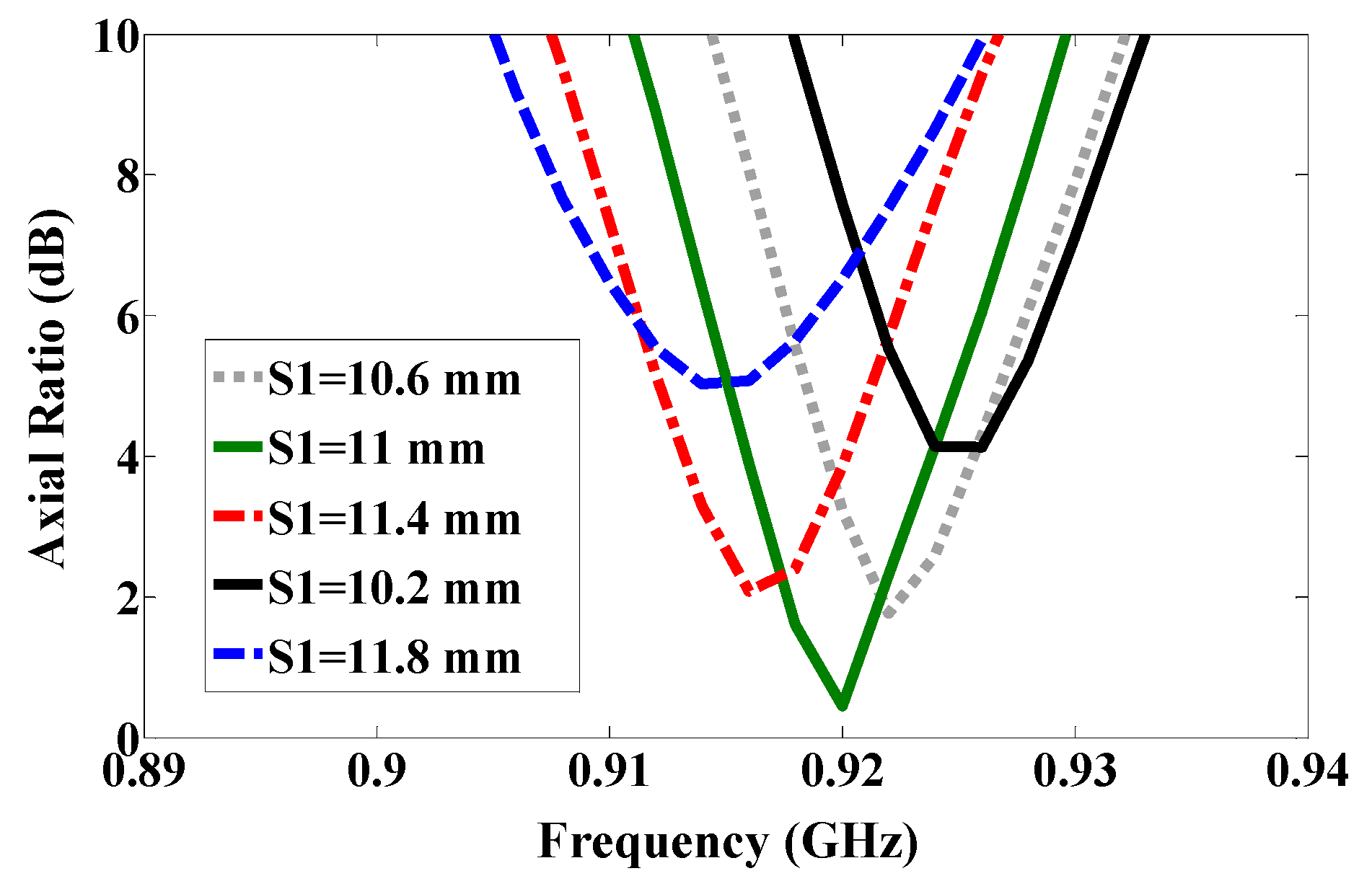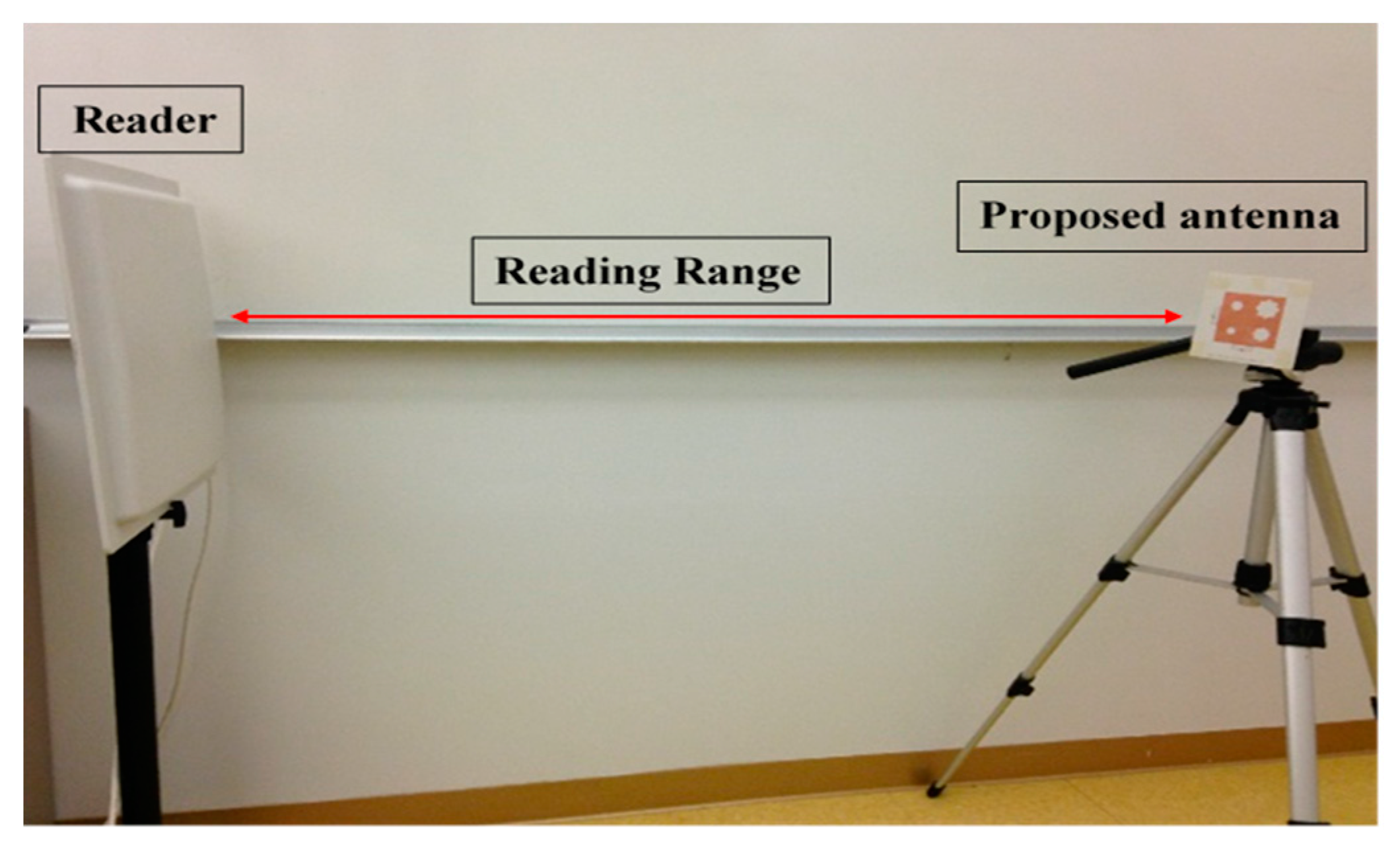Multiport Circular Polarized RFID-Tag Antenna for UHF Sensor Applications
Abstract
:1. Introduction
2. CP-ASSSMP Design
3. RFID Antenna Design
4. Sensor Design
5. Results and Discussion
5.1. The Passive RFID Antenna Results
5.2. RFID Temperature Sensor Measurements
6. Conclusions
Author Contributions
Conflicts of Interest
References
- Cho, C.; Park, I.; Choo, H. Design of a Circularly Polarized Tag Antenna for Increased Reading Range. IEEE Trans. Antennas Propag. 2009, 57, 3418–3422. [Google Scholar]
- Gautam, A.; Kunwar, A.; Kanaujia, B. Circularly Polarized Arrowhead-Shape Slotted Microstrip Antenna. IEEE Antennas Wirel. Propag. Lett. 2014, 13, 471–474. [Google Scholar] [CrossRef]
- Chen, H.; Sim, C.; Kuo, C. Compact Circularly Polarized Meandered-loop Antenna for UHF-Band RFID Tag. IEEE Antennas Wirel. Propag. Lett. 2016, 15, 1602–1605. [Google Scholar] [CrossRef]
- Chen, H.; Tsia, C.; Sim, C.; Kuo, C. Circularly Polarized loop Tag Antenna for Long Reading Range RFID Applications. IEEE Antennas Wirel. Propag. Lett. 2013, 12, 1460–1463. [Google Scholar] [CrossRef]
- Wang, Z.; Fang, S.; Fu, S.; Jia, S. Single-Fed Broadband Circularly Polarized Stacked Patch Antenna with Horizontally Meandered Strip for Universal UHF RFID Applications. IEEE Trans. Microw. Theory Tech. 2011, 57, 1066–1073. [Google Scholar] [CrossRef]
- Sim, C.; Chi, C. A Slot Loaded Circularly Polarized Patch Antenna for UHF RFID Reader. IEEE Trans. Antennas Propag. 2012, 60, 4516–4521. [Google Scholar] [CrossRef]
- Chen, H.; Sim, C.; Kuo, S. Compact Broadband Dual Coupling- Feed Circularly polarized RFID Microstrip Tag Antenna Mountable on Metallic Surface. IEEE Trans. Antennas Propag. 2012, 60, 4516–4521. [Google Scholar] [CrossRef]
- Chen, H.; Kuo, S.; Sim, C.; Tsai, C. Coupling-Feed Circularly Polarized RFID Tag Antenna Mountable on Metallic Surface. IEEE Trans. Antennas Propag. 2012, 60, 2166–42174. [Google Scholar] [CrossRef]
- Lu, J.; Chang, B. Planar Compact Square-Ring Tag Antenna with Circular Polarization for UHF RFID Applications. IEEE Trans. Antennas Propag. 2017, 65, 432–441. [Google Scholar] [CrossRef]
- Fang, Z.; Jin, R.; Geng, J. Asymmetric dipole antenna suitable for active RFID tags. Electron. Lett. 2008, 44, 71–72. [Google Scholar] [CrossRef]
- Abdulhadi, A.; Abhari, R. Design and experimental evaluation of miniaturized monopole UHF RFID tag antennas. IEEE Antennas Wirel. Propag. Lett. 2012, 11, 248–251. [Google Scholar] [CrossRef]
- Marrocco, G. The art of UHF RFID antenna design: Impedance matching and size-reduction techniques. IEEE Antennas Propag. Mag. 2008, 50, 66–79. [Google Scholar] [CrossRef]
- Lu, J.; Zheng, G. Planar Broadband Tag Antenna Mounted on the Metallic Material for UHF RFID System. IEEE Antennas Wirel. Propag. Lett. 2011, 10, 1405–1408. [Google Scholar]
- Gao, J.; Siden, J.; Nilsson, H. Printed Electromagnetic Coupler With an Embedded Moisture Sensor for Ordinary Passive RFID Tags. IEEE Electron. Device Lett. 2011, 32, 1767–1769. [Google Scholar] [CrossRef]
- Gao, J.; Siden, J.; Nilsson, H.; Gulliksson, M. Printed humidity sensor with memory functionality for passive RFID tags. IEEE Sens. J. 2013, 13, 1824–1834. [Google Scholar] [CrossRef]
- Kim, S.; Kawahara, Y.; Georgiadis, A.; Collado, A.; Tentzeris, M.M. Low-cost inkjet-printed fully passive RFID tags for calibration-free capacitive/haptic sensor applications. IEEE Sens. J. 2015, 15, 3135–3145. [Google Scholar] [CrossRef]
- Siden, J.; Zeng, X.; Unander, T.; Koptyug, A.; Nilsson, H.-E. Remote moisture sensing utilizing ordinary RFID tags. In Proceedings of the IEEE Sensors, Atlanta, GA, USA, 28–31 October 2007; pp. 308–311. [Google Scholar]
- Abdulhadi, A.; Abahari, R. Multiport UHF RFID-Tag Antenna for Enhanced Energy Harvesting of Self-Powered Wireless Sensors. IEEE Trans. Ind. Inform. 2016, 12, 801–808. [Google Scholar] [CrossRef]
- Marrocco, G.; Mattioni, L.; Calabrese, C. Multiport sensor RFIDs for wireless passive sensing of objects-basic theory and early results. IEEE Trans. Antennas Propag. 2008, 56, 2691–2702. [Google Scholar] [CrossRef]
- Caizzone, S.; Occhiuzzi, C.; Marrocco, G. Multi-chip RFID Antenna Integrating Shape-Memory Alloys for detection of Thermal Thresholds. IEEE Trans. Antennas Propag. 2011, 59, 2488–2494. [Google Scholar] [CrossRef]
- Marrocco, G. RFID Grids: Part I—Electromagnetic Theory. IEEE Trans. Antennas Propag. 2011, 59, 1019–1026. [Google Scholar] [CrossRef]
- Marrocco, G.; Caizzone, S. Multi-chip RFID Grids. In Proceedings of the IEEE International Symposium on Antennas and Propagation (APSURSI), Washington, DC, USA, 3–7 July 2011; pp. 1085–1088. [Google Scholar]














| References | 1 | 3 | 5 | 7 | 8 | 9 | 18 | Proposed Design |
|---|---|---|---|---|---|---|---|---|
| Operating frequency (MHz) | 860–960 | 915–942 | 758–983 | 902–927 | 904–954 | 860–960 | 902–928 | 902–929 |
| Dimensions mm3 | 189.6 × 127.9 × 21.6 | 58.6 × 58.6 × 0.4 | 250 × 250 × 33.8 | 100 × 100 × 1.6 | 70 × 70 × 1.6 | 54 × 54 × 5.2 | 130 × 130 × 1.52 | 130 × 130 × 1.52 |
| Reading Range (m) | 8 | 20.5 | 7 | 4.62 | 4.83 | 8.3 | 7.48 | 25 |
© 2017 by the authors. Licensee MDPI, Basel, Switzerland. This article is an open access article distributed under the terms and conditions of the Creative Commons Attribution (CC BY) license (http://creativecommons.org/licenses/by/4.0/).
Share and Cite
Zaid, J.; Abdulhadi, A.; Kesavan, A.; Belaizi, Y.; Denidni, T.A. Multiport Circular Polarized RFID-Tag Antenna for UHF Sensor Applications. Sensors 2017, 17, 1576. https://doi.org/10.3390/s17071576
Zaid J, Abdulhadi A, Kesavan A, Belaizi Y, Denidni TA. Multiport Circular Polarized RFID-Tag Antenna for UHF Sensor Applications. Sensors. 2017; 17(7):1576. https://doi.org/10.3390/s17071576
Chicago/Turabian StyleZaid, Jamal, Abdulhadi Abdulhadi, Arun Kesavan, Yassin Belaizi, and Tayeb A. Denidni. 2017. "Multiport Circular Polarized RFID-Tag Antenna for UHF Sensor Applications" Sensors 17, no. 7: 1576. https://doi.org/10.3390/s17071576
APA StyleZaid, J., Abdulhadi, A., Kesavan, A., Belaizi, Y., & Denidni, T. A. (2017). Multiport Circular Polarized RFID-Tag Antenna for UHF Sensor Applications. Sensors, 17(7), 1576. https://doi.org/10.3390/s17071576




